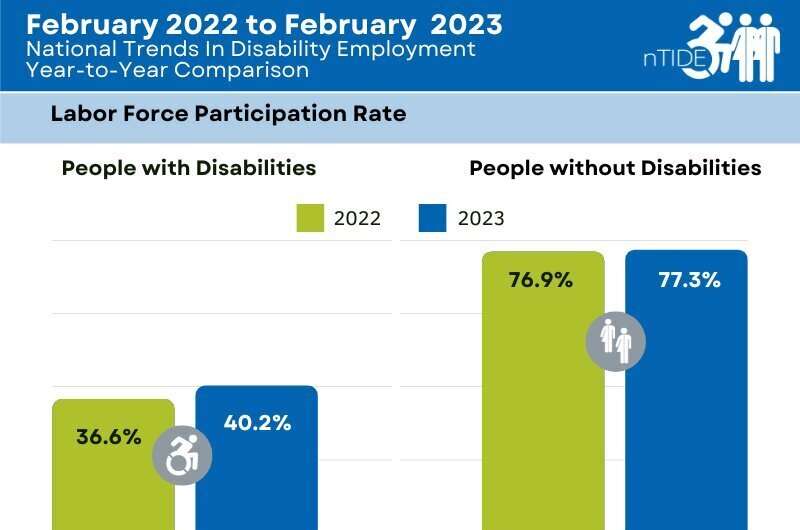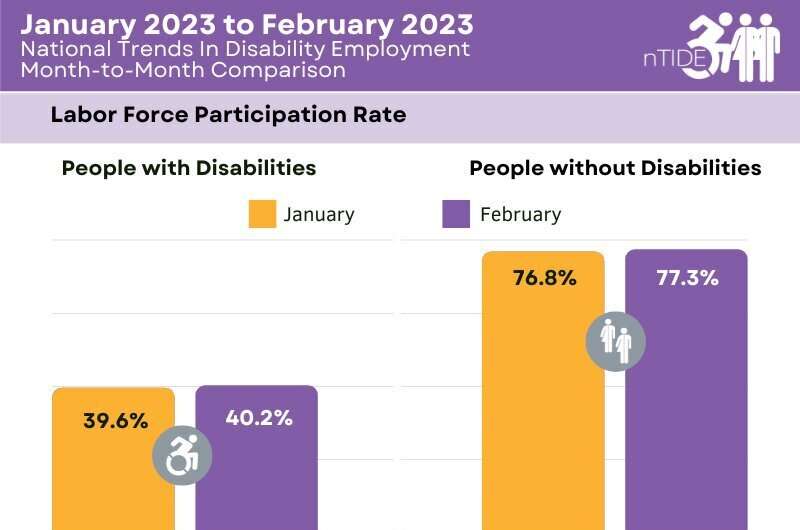This article has been reviewed according to Science X's editorial process and policies. Editors have highlighted the following attributes while ensuring the content's credibility:
fact-checked
proofread
Report: People with disabilities engaging in labor force at record rates

The labor force participation rate reached an all-time high for people with disabilities in February, according to today's National Trends in Disability Employment—semi-monthly update (nTIDE), issued by Kessler Foundation and the University of New Hampshire's Institute on Disability (UNH-IOD).
Comparing the year-to-year job indicators, nTIDE experts reported narrowing of the employment gap between people with and without disabilities, consistent with the pandemic-era trend for people with disabilities outperforming their counterparts without disabilities in the labor market.
Year-to-year nTIDE numbers (comparing February 2022 to February 2023)
Based on data from the U.S. Bureau of Labor Statistics (BLS) Jobs Report released today, the labor force participation rate for people with disabilities (ages 16-64) increased from 36.6 percent in February 2022 to an all-time high of 40.2 percent in February 2023 (up 9.8 percent or 3.6 percentage points). For people without disabilities (ages 16-64), the labor force participation rate also increased from 76.9 percent in February 2022 to 77.3 percent in February 2023 (up 0.5 percent or 0.4 percentage points).
The labor force participation rate reflects the percentage of people who are in the labor force (working, on temporary layoff, on furlough, or actively looking for work in the last four weeks) relative to the total population (the number of people in the labor force divided by the number of people in the total population multiplied by 100).
"Over the course of the COVID-19 pandemic, people with disabilities remained in the labor force and are now participating in the labor force at record rates, reaching just above 40 percent in February for the first time since the BLS began collecting data on people with disabilities in 2008," remarked Andrew Houtenville, Ph.D., professor of economics and research director of the UNH-IOD. "Several factors may be influencing the increased participation of people with disabilities, including an increase in job opportunities and a pressing need to work as families face rising prices," he added.
With regard to employment, the employment-to-population ratio for working-age people with disabilities (ages 16-64) increased from 33.1 percent in February 2022 to 36.9 percent in February 2023 (up 11.5 percent or 3.8 percentage points). For working-age people without disabilities (ages 16-64), the employment-to-population ratio also increased from 73.8 percent in February 2022 to 74.4 percent in February 2023 (up 0.8 percent or 0.6 percentage points). The employment-to-population ratio, a key indicator, reflects the percentage of people who are working relative to the total population (the number of people working divided by the number of people in the total population multiplied by 100).
"We saw narrowing of the gap in the employment-to-population ratio between people with and without disabilities from February 2022 to this year," said John O'Neill, Ph.D., director of the Center for Employment and Disability Research at Kessler Foundation. "This is consistent with the gains we have seen as people with disabilities made a strong recovery from the pandemic," he added.
"Narrowing of the employment gap is also supported by the findings of Kessler Foundation's latest survey, the 2022 National Employment & Disability Survey: Effects of COVID-19 Pandemic on Supervisor Perspectives, which shows an increase in practices that facilitate the recruitment, hiring, and retention of people with disabilities."

Month-to-month nTIDE numbers (comparing January 2023 to February 2023)
Reflecting seasonal effects, the labor force participation rate for people with disabilities (ages 16-64) increased slightly from 39.6 percent in January 2023 to 40.2 percent in February 2023 (up 1.5 percent or 0.6 percentage points). For people without disabilities (ages 16-64), the labor force participation rate also increased slightly from 76.8 percent in January 2023 to 77.3 percent in February 2023 (up 0.7 percent or 0.5 percentage points).
Similarly, the employment-to-population ratio for people with disabilities (ages 16-64) increased slightly from 36.7 percent in January 2023 to 36.9 percent in February 2023 (up 0.5 percent or 0.2 percentage points). For people without disabilities (ages 16-64), the employment-to-population ratio also increased slightly from 73.9 percent in January 2023 to 74.4 percent in February 2023 (up 0.7 percent or 0.5 percentage points).
In February 2023, among workers ages 16-64, the 5,973,000 workers with disabilities represented 4.0 percent of the total 149,028,000 workers in the U.S.
Note: The statistics in the nTIDE are based on BLS numbers but are not identical. They are customized by UNH to combine the statistics for men and women of working age (16- 64).
Provided by Kessler Foundation





















